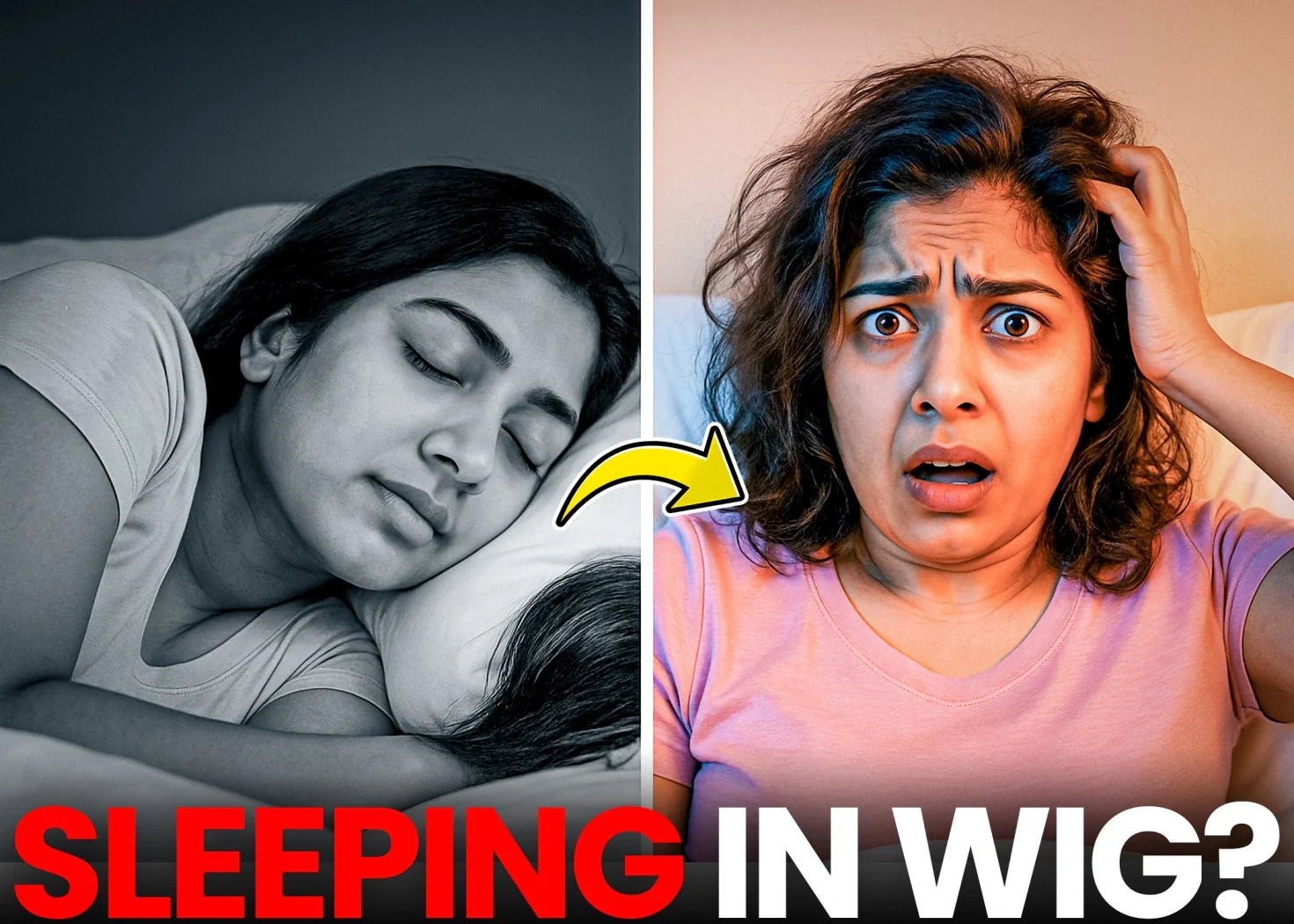What Happens If You Sleep in a Wig? Here’s the Truth

The Surprising Reality of Sleeping in Wigs
Many wig wearers assume that sleeping in a wig is harmless, especially if it feels secure and comfortable. But the truth is, regular overnight wear causes far more damage than most people expect and the effects often show up when it’s too late to reverse them.
Eye Opening Stats & What They Really Mean:
-
78% of wig users admit to occasionally sleeping in their wigs:
Most do it out of convenience, emotional comfort, or fatigue. But even infrequent overnight wear shortens the lifespan of wigs and impacts scalp health.
-
Synthetic wigs show visible damage after just 3–5 nights:
Synthetic wigs are delicate. Sleeping in them causes tangling, permanent matting, and breakdown of fibers especially in high friction areas like the nape.
-
Human hair wigs lose up to 40% of their lifespan with regular overnight use:
Even premium 100% human hair wigs suffer. Friction depletes moisture, damaged cuticles, and dulls the texture far faster than normal wear.
-
Medical wig wearers are 3x more likely to sleep in their wigs:
For patients undergoing chemo or managing wigs for alopecia, emotional need often outweighs physical maintenance. But they also face more cumulative damage.
-
92% of stylists recommend against sleeping in wigs:
Hair professionals agree overnight wear, especially without protection, reduces the lifespan and quality of even the best natural looking wigs.
Sleeping in a wig is about more than comfort, it's about risk. If you absolutely must, do it wisely. Use a satin pillowcase, wrap the wig in a scarf, or invest in a separate wig for chemo or overnight use. Your main wig isn’t just a beauty product it’s your identity, your courage, your confidence.
|
Table of Contents |
| Overnight Effects on Your Wig |
| Scalp Health Risks |
| When Sleeping in a Wig Is Needed |
| Pro Tips to Minimize Damage |
| Best Wig Types for Overnight Wear |
What Really Happens to Your Wig Overnight
Whether you wear human hair wigs, or glue less lace wigs, the transformation they undergo overnight is significant. Movement, body heat, and friction combine to create a harsh environment for your wig, leading to physical changes that are often irreversible.
Issue |
How It Affects Your Wig |
Suggested Solution |
| Fiber Deformation | Friction and heat kink synthetic strands or damage the hair shaft in full lace human hair wigs. |
Use satin pillowcases and braid or wrap hair to minimize friction. |
| Severe Tangling | High friction areas like the nape get matted and difficult to detangle. | Detangle before and after sleep; secure in a loose braid or scarf. |
| Product Transfer | Oils, sweat, and products transfer to pillowcases, dirtying both the wig and bedding. | Use minimal styling products and change pillowcases regularly. |
| Cap Stretching | Elastic bands in wigs for women stretch, causing poor fit and instability. | Rotate between wigs and avoid tight caps overnight. |
| Adhesive Breakdown | Adhesives on glue less lace wigs can loosen due to heat and sweat. | Choose breathable cap designs and avoid adhesives during sleep. |
| Cuticle Erosion | In 100% human hair wigs, cuticles wear down, making hair rough and dry. | Use a leave-in conditioner and avoid rubbing hair against pillows. |
| Moisture Loss | Overnight dryness makes the hair brittle and dull. | Spray a hydrating mist before bed and deep condition weekly. |
| Uneven Oil Distribution | Some areas get greasy while others dry out, causing uneven texture. | Gently brush to redistribute oils and wash wigs more frequently. |
| Color Fading | Especially in dyed wigs for women with cancer, friction dulls vibrancy. | Avoid sunlight, use color-protectant products, and store properly. |
| Loss of Style Memory | Heat styled curls or waves fall flat, particularly in natural looking wigs. | Use heatless rollers or refresh with steam or mousse. |
Serious Scalp Health Concerns to Consider
Sleeping in wigs does more than harm the hair fibers it can also lead to serious scalp issues. Dermatologists report a rise in wig related scalp problems, especially among long term overnight users. Without proper care and ventilation, the scalp becomes a breeding ground for irritation and infections.
Common Scalp Problems from Overnight Wig Use:
-
Traction Alopecia:
Caused by tight or poorly fitted wigs for women, this condition results in hair loss around the hairline due to constant tension and pulling.
-
Fungal Infections:
Moisture trapped under the wig can create the perfect environment for fungal growth. This is especially risky with wigs for women with cancer whose scalps are already sensitive.
-
Folliculitis:
Repeated friction and lack of airflow can lead to inflammation of the hair follicles, causing itchy, red bumps and discomfort.
-
Contact Dermatitis:
Adhesives used in glue less lace wigs or full lace human hair wigs can trigger allergic reactions, especially when left on for prolonged periods.
-
Increased Oil Production:
The scalp may overcompensate for lack of ventilation by producing more oil, which clogs pores and can worsen irritation.
Warning Signs to Watch For:
- Persistent itching or burning
- Redness, flaking, or dryness
- Pain or tenderness at the hairline
- Unusual or patchy hair shedding
- Pimple like bumps or scalp acne
To prevent these problems, allow your scalp to breathe regularly, maintain strict hygiene, and opt for breathable real wigs especially designed for comfort.
When You Absolutely Must Sleep in Your Wig
For some wearers, removing their wig at night isn’t always an option. Medical conditions, emotional comfort, or travel constraints may make it necessary to wear wigs for extreme hair loss around the clock. If that's the case, strategic measures can make all the difference.
Situations That May Require Overnight Wig Wear:
-
Medical Hair Loss Treatment:
Chemotherapy or alopecia patients rely on wigs for confidence and emotional support.
-
Post-Surgical Recovery:
Patients may avoid wig removal due to limited mobility or the need to remain lying down.
-
Travel Circumstances:
In shared accommodations or long journeys, sleeping in your wig may be necessary for convenience.
-
Personal Comfort:
Some feel psychologically more secure sleeping in their wigs for women with alopecia.
-
Special Occasions:
Weddings or events with early starts might require wearing your wig overnight for styling purposes.
Damage Control Essentials:
- Speak with your doctor or oncology nurse before choosing a sleep safe wig for chemotherapy.
- Buy from retailers that specialize in wigs for cancer or wigs for women with alopecia.
- Consider alternatives like turbans or soft sleep caps on rest days.
Professional-Approved Damage Control Methods
If overnight wear is unavoidable, these damage control techniques recommended by experts who work with wigs for women with cancer, wigs for alopecia can help minimize harm.
1. Pre-Sleep Preparation:
-
Gently Detangle Hair:
Always use a wide tooth comb to remove knots and prevent matting in your natural looking wigs.
-
Apply Light Moisturizer:
A light spritz of leave in conditioner maintains softness, especially for 100% human hair.
-
Braid or Wrap Hair:
Reduces friction and holds style overnight ideal for full lace human hair wigs.
-
Use Satin Scrunchies:
Prevent breakage without the tug of elastic bands.
2. Bedtime Environment:
-
Satin or Silk Pillowcase:
These create less friction than cotton and help protect the wig fibers.
-
Multiple Pillows:
Elevating the head reduces rolling, minimizing movement and fiber stress.
-
Cool Room Temperature:
Reduces sweat buildup under the wig cap.
-
Careful Hair Positioning:
Keeps the wig from pressing or shifting out of place during sleep.
3. Morning Recovery:
-
Gentle Detangling:
Start from the ends and move upward to protect the integrity of real wigs.
-
Light Conditioning Spray:
Helps revive texture and smooth fly aways.
-
Air Dry if Damp:
Let your wig breathe before styling to prevent mildew.
-
Style Refresh Products:
Use heat protectant sprays or mousse on wigs for women if restyling is needed.
4. Cleaning Protocol:
-
Wash 2–3x More Frequently:
Sleeping in your wig accelerates buildup.
-
Use Sulfate-Free Formulas:
Preserves fiber and moisture.
-
Deep Condition Weekly:
Vital for longevity, especially for human hair wigs.
-
Rotate Between Wigs:
Prevents excessive wear on a single unit.
-
Schedule Monthly Professional Cleaning:
Especially important for high end full lace human hair wigs.
Best Wig Types for Occasional Overnight Wear
Not all wigs are created equal some are better suited for the demands of occasional sleep wear than others. Choose wisely based on construction and material.
Wig Type |
Sleep Suitability |
Best Features |
| 100% Human Hair Wigs | Moderate | Natural texture, durability, can be restyled ideal with care |
| Full Lace Human Hair Wigs | Low–Moderate | Realistic look, but delicate only with high protection |
| Glue less Lace Wigs | High | Comfortable fit, no adhesives best for overnight use |
| Wigs for Cancer | Moderate–High | Designed for comfort during medical recovery |
| Wigs for Women with Alopecia | High | Often breathable, capless or lined for scalp protection |
| Synthetic Wigs | Low | Affordable, but prone to friction damage and tangling |
Always prioritize construction designed for comfort and breathability when choosing a wig for chemo or overnight needs.
Final Verdict: Should You Ever Do It?
After careful analysis and expert input, the answer is clear: if possible, avoid sleeping in your wig. The risks to your 100% human hair, natural looking wigs, and more importantly your scalp health are real.
However, life isn’t always predictable. For those moments when overnight wear is unavoidable, there are ways to do it safely. Invest in breathable, well-made wigs for confidence, build a solid nighttime routine, and be vigilant about hygiene and scalp care.
Professional Consensus:
- Remove wigs nightly when you can
- Store properly on a stand to preserve shape
- Invest in silk accessories and sleep caps
- Stick to strict cleaning and care protocols
- Monitor for any scalp irritation or sensitivity
Medical Wearer Advice:
-
Work with certified specialists for wigs for women with alopecia or wigs for cancer
- Consider comfortable alternatives like sleep caps or scarves
- Always put scalp comfort above appearance if it’s causing distress
- Join support groups emotional well being matters just as much as physical
With the right information and smart care practices, you can wear your wig overnight safely and confidently when it matters most.
Take the first step toward confident hair today! 📞 +91 9967123333 Call us for a personalized consultation and discover the most effective solution for your hair needs.
Need help finding the most natural wig for your journey?
Whether you’re undergoing treatment or just exploring options, we’re here to guide you with care.👉 [Fill out this form] and our wig specialists will help you find the perfect match natural, comfortable, and confidence-boosting.
need help?






Leave a comment
This site is protected by hCaptcha and the hCaptcha Privacy Policy and Terms of Service apply.